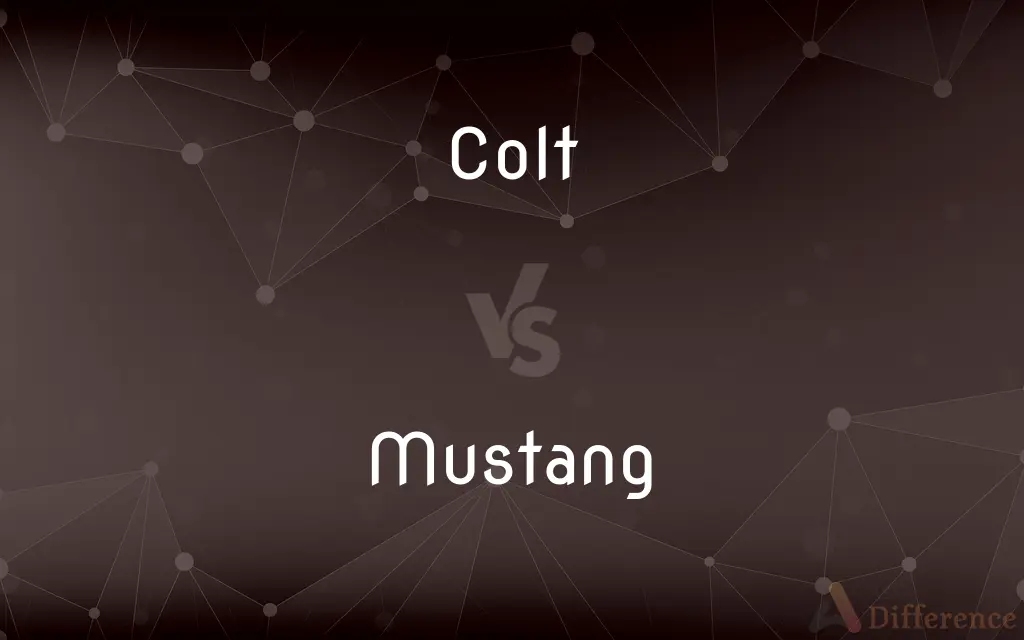Colt vs. Mustang — What's the Difference?
Edited by Tayyaba Rehman — By Urooj Arif — Updated on March 17, 2024
A colt is a young male horse, while a mustang is a free-roaming horse of the American West.

Difference Between Colt and Mustang
Table of Contents
ADVERTISEMENT
Key Differences
A colt refers specifically to a young male horse, typically under four years of age. The term is used to describe the early life stage of a horse, focusing on age and gender. On the other hand, a mustang is a term that describes a specific type of horse known for its wild or feral existence, particularly in the western United States, regardless of its age or gender.
Colts, due to their age, are often in the process of training and development. They may be seen learning basic commands, social behaviors, and sometimes beginning their training for riding or work. Mustangs, however, are known for their independence and survival skills, honed by living in the wild. They might be captured and trained, but their wild origin contributes to their resilience and distinctive behaviors.
The term "colt" can apply to any breed of horse, simply indicating the animal's young age and male gender. In contrast, mustangs are a specific group that descended from horses brought to the Americas by Spanish explorers. Over generations, these horses adapted to the wild landscapes of the American West, developing into the mustang breed known today.
While colts are often associated with domestic care and upbringing, mustangs symbolize the untamed spirit of the American West. The contrast between a colt's upbringing and a mustang's wild life highlights the diverse conditions in which horses can thrive, from controlled environments to natural, open ranges.
Understanding the difference between a colt and a mustang is essential for appreciating the various aspects of equine life, from the controlled development of domestic horses to the natural evolution and survival of wild breeds.
ADVERTISEMENT
Comparison Chart
Definition
Young male horse under four years
Free-roaming horse of the American West
Age & Gender
Up to 4 years, male
Any age, any gender
Training
Often in training, learning basics
Wild, may be untamed or later trained
Origin
Any breed
Descended from Spanish horses, adapted to wild
Symbolism
Growth, training, potential
Independence, resilience, wild spirit
Compare with Definitions
Colt
A young male horse under the age of four.
The farmer's colt was learning to respond to basic commands.
Mustang
A free-roaming horse of the American West, often wild.
The mustang galloped freely across the open plains.
Colt
Requires care and training from humans.
The colt's training included being led by a halter and getting used to saddles.
Mustang
Can be captured and trained, but retains a wild spirit.
The trained mustang still had a spark of wildness in its eyes.
Colt
Subject to domestic upbringing and training.
The colt was gentle and showed promise as a future racing horse.
Mustang
Known for its resilience and independence.
The mustang, with its rugged build, survived the harsh winter.
Colt
Represents potential and early development stages.
Watching the colt play in the field, one could see his future potential.
Mustang
Descended from horses brought by Spanish explorers.
The mustang's lineage traced back to the horses of the Spanish conquistadors.
Colt
Can belong to any horse breed.
The Arabian colt showed the distinctive features of his breed.
Mustang
Symbolizes the untamed spirit of the American West.
The mustang stood as a symbol of freedom in the vast landscapes.
Colt
A type of revolver.
Mustang
The mustang is a free-roaming horse of the Western United States, descended from horses brought to the Americas by the Spanish. Mustangs are often referred to as wild horses, but because they are descended from once-domesticated animals, they are actually feral horses.
Colt
A young male horse, especially an ungelded racehorse less than five years old, or a young male of another equine species.
Mustang
An American feral horse which is typically small and lightly built.
Colt
A youthful or inexperienced person; a novice.
Mustang
A small, hardy wild horse of the North American plains, descended from horses brought to America by Spanish explorers and European settlers.
Colt
A young male horse.
Mustang
A small, hardy, naturalized (feral) horse of the North American west.
Colt
A young crane (bird).
Mustang
A merchant marine who joined the U.S. Navy as a commissioned officer during the American Civil War.
Colt
(figuratively) A youthful or inexperienced person; a novice.
Mustang
A commissioned officer who started military service as an enlisted person.
Colt
A professional cricketer during his first season.
Mustang
(US) To hunt mustangs wild horses, either for military use or for slaughter as pet food.
Colt
(nautical) A short piece of rope once used by petty officers as an instrument of punishment.
Mustang
The half-wild horse of the plains in Mexico, California, etc. It is small, hardy, and easily sustained.
Colt
(biblical) A young camel or donkey.
Mustang
Small hardy range horse of the western plains descended from horses brought by the Spanish
Colt
To horse; to get with young.
Colt
To befool.
Colt
To frisk or frolic like a colt; to act licentiously or wantonly.
Colt
The young of the equine genus or horse kind of animals; - sometimes distinctively applied to the male, filly being the female. Cf. Foal.
Colt
A young, foolish fellow.
Colt
A short knotted rope formerly used as an instrument of punishment in the navy.
Colt
To frisk or frolic like a colt; to act licentiously or wantonly.
They shook off their bridles and began to colt.
Colt
To horse; to get with young.
Colt
To befool.
Colt
A young male horse under the age of four
Colt
A kind of revolver
Common Curiosities
How does the upbringing of a colt differ from that of a mustang?
Colts are usually raised in a domestic setting with human care and training, while mustangs grow up wild, learning survival skills in nature.
What is the primary difference between a colt and a mustang?
A colt is a young male horse, while a mustang is a free-roaming horse of the American West.
Are all wild horses in America called mustangs?
Mustangs are a specific type of free-roaming horse in the West, but not all wild horses in America are mustangs.
Why are mustangs significant in American history?
They symbolize the untamed spirit of the West and are descendants of the first horses brought to the Americas by Spanish explorers.
What happens when a mustang is captured?
Captured mustangs can be trained for riding, work, or companionship, but they often retain some aspects of their wild nature.
Is it legal to own a mustang?
Yes, through government-managed adoption programs, people can legally own mustangs, though there are specific requirements and responsibilities.
Can mustangs be part of a herd?
Yes, mustangs often live in herds, which provides social structure and increases their chances of survival in the wild.
What is the life expectancy of a mustang compared to domestic horses?
Life expectancy can vary, but mustangs may live shorter lives than domestic horses due to the harsh conditions of their environment.
Can a colt be a mustang?
Yes, a young male mustang would technically be a colt until it reaches maturity.
How do you identify a colt?
Colts are identified by their age (under four years) and gender (male), along with youthful characteristics and behaviors.
What challenges do mustangs face in the wild?
Mustangs face challenges such as habitat loss, competition for resources, and environmental extremes.
Can mustangs be found outside the American West?
While mustangs are primarily associated with the American West, wild horse populations exist in other parts of the world, though they may not be called mustangs.
How has the image of the mustang influenced American culture?
The mustang has become an iconic symbol of freedom, resilience, and the untamed American frontier.
Are mustangs protected in the United States?
Mustangs are protected under federal law, but they also face management challenges due to their growing populations and habitat pressures.
Do colts play a specific role in horse society?
Colts, like all young animals, are learning their place in the social hierarchy, developing social skills and behaviors.
Share Your Discovery

Previous Comparison
Load vs. Lade
Next Comparison
Outcry vs. ExpressAuthor Spotlight
Written by
Urooj ArifUrooj is a skilled content writer at Ask Difference, known for her exceptional ability to simplify complex topics into engaging and informative content. With a passion for research and a flair for clear, concise writing, she consistently delivers articles that resonate with our diverse audience.
Edited by
Tayyaba RehmanTayyaba Rehman is a distinguished writer, currently serving as a primary contributor to askdifference.com. As a researcher in semantics and etymology, Tayyaba's passion for the complexity of languages and their distinctions has found a perfect home on the platform. Tayyaba delves into the intricacies of language, distinguishing between commonly confused words and phrases, thereby providing clarity for readers worldwide.















































